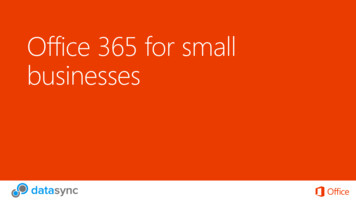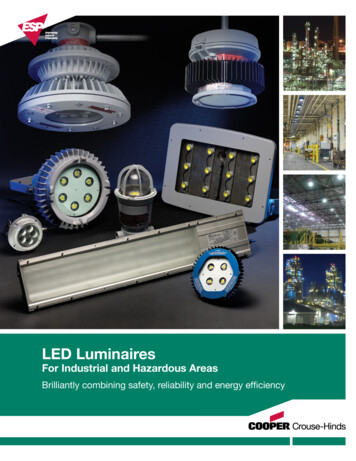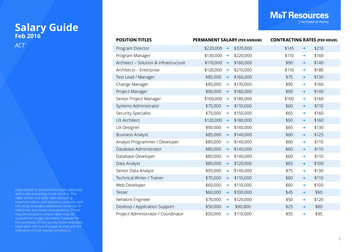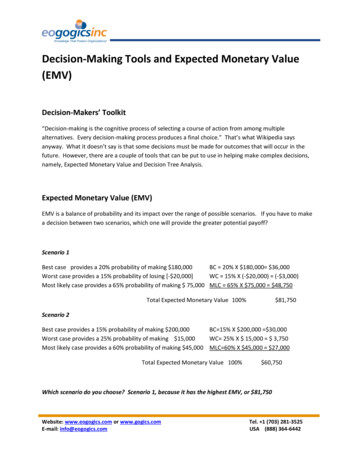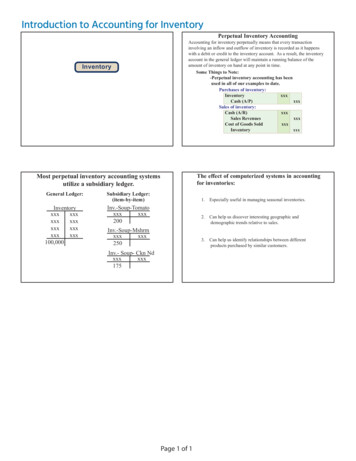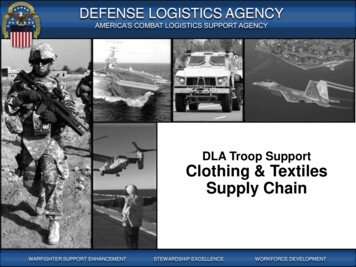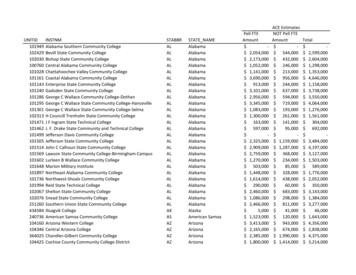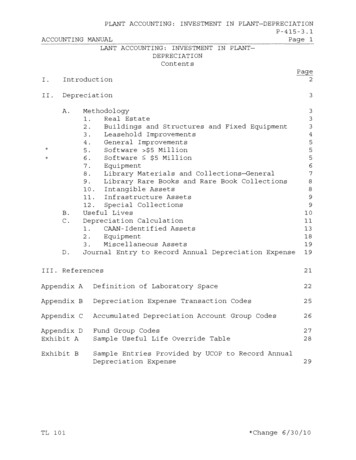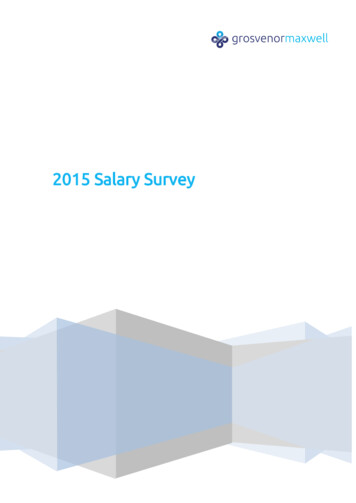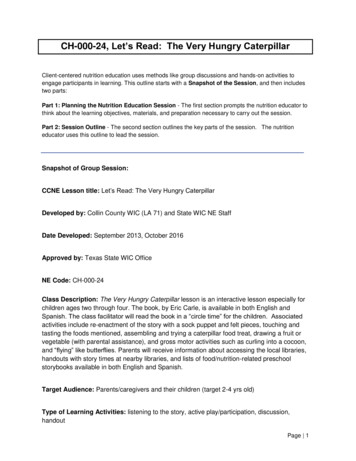
Transcription
CH-000-24, Let’s Read: The Very Hungry CaterpillarClient-centered nutrition education uses methods like group discussions and hands-on activities toengage participants in learning. This outline starts with a Snapshot of the Session, and then includestwo parts:Part 1: Planning the Nutrition Education Session - The first section prompts the nutrition educator tothink about the learning objectives, materials, and preparation necessary to carry out the session.Part 2: Session Outline - The second section outlines the key parts of the session. The nutritioneducator uses this outline to lead the session.Snapshot of Group Session:CCNE Lesson title: Let’s Read: The Very Hungry CaterpillarDeveloped by: Collin County WIC (LA 71) and State WIC NE StaffDate Developed: September 2013, October 2016Approved by: Texas State WIC OfficeNE Code: CH-000-24Class Description: The Very Hungry Caterpillar lesson is an interactive lesson especially forchildren ages two through four. The book, by Eric Carle, is available in both English andSpanish. The class facilitator will read the book in a “circle time” for the children. Associatedactivities include re-enactment of the story with a sock puppet and felt pieces, touching andtasting the foods mentioned, assembling and trying a caterpillar food treat, drawing a fruit orvegetable (with parental assistance), and gross motor activities such as curling into a cocoon,and “flying” like butterflies. Parents will receive information about accessing the local libraries,handouts with story times at nearby libraries, and lists of food/nutrition-related preschoolstorybooks available in both English and Spanish.Target Audience: Parents/caregivers and their children (target 2-4 yrs old)Type of Learning Activities: listening to the story, active play/participation, discussion,handoutPage 1
Part 1: Planning the Nutrition Education SessionLesson: CH-000-24, Let’s Read: The Very Hungry Caterpillar.ItemNotes for Planning the SessionLearning Objective(s) – Whatwill the clients gain from theclass?By the end of the session, children will: Touch and taste different fruits and vegetables. Answer questions about which foods the caterpillar tried. Draw a favorite fruit or vegetable, with help from a parent. Be introduced to a classic children’s story book. Learn about the life cycle of the butterfly.Parents will:Key Content Points – Whatkey information do the learnersneed to know to achieve thelearning objective(s)? Aim forthree main points. Be introduced to a classic preschool book. Receive information about local libraries and story times. Receive a list of other nutrition/food-related preschool storybooksin English and Spanish. Be introduced to ways reading and associated activities fosterparent/child interaction.For the children:1. Fruits and vegetables taste good and help me grow.2. Caterpillars also eat in order to grow and become butterflies.3. Reading and books are fun.For the parents:1. Leave with information about accessing local libraries.2. Leave with list of food/nutrition-related preschool storybooksavailable in both English and Spanish.Materials – List what you willneed for the session (i.e. visual The Very Hungry Caterpillar by Eric Carle in both English andSpanishPage 2
aids, handouts, supplies).Attach supplemental materials. Public library handouts with story times and information for joiningthe library Handout of food/nutrition storybooks available in English andSpanish Paper and washable markers Samples of the foods mentioned in the story. Green fuzzy sock made into a caterpillar puppet. Felt pieces for 1apple, 2 pears, 3 plums, 4 strawberries, 5 oranges, and anotherbigger sock to be a cocoon for the caterpillar Blanket to sit on for story time Thinly sliced cucumber, cherry tomato halves to make caterpillars,paper platesResources – Review currentWIC resources or other reliableresources like WIC Works.Other Children’s Classes lesson plans on the WIC state agency website.Class Flow & Set Up –Consider the flow of thesession & room set-up. Noteany extra preparation that maybe needed.Set up includes: Children’s area on floor with a blanket for children to sit and listento the story; optional small chair for the facilitator Books, puppet, and props in story time area Separate table with paper plates of caterpillar food treat for eachchild (one plate per child so only the child/his parent are touchingthe food) Children’s table/chairs with paper and washable markers.Parent’s chairs are behind the children’s chairs so the parents canassist with drawing and assembling the food treat. Cut up food samples in small paper cups/napkins Post surveys/pencils for parents Prior to the session, food must be assembled and placed incups/plates.Page 3
Part 2: Session OutlineLesson: CH-000-24, Let’s Read: The Very Hungry Caterpillar.ItemIntroduction: Create arespectful and acceptinglearning environment bywelcoming participants,introducing yourself,reviewing agenda, exploringground rules, makingannouncements, etc.Notes for Conducting the SessionHi, my name is Ms. , and we’re going to do something different atWIC today! Guess what we’re going to do! (Children, with help from parents,can answer.) We’re going to read a book called The Very Hungry Caterpillar. Who knows what a caterpillar is? What color is this caterpillar? What kinds of foods do you think this caterpillar will eat? We’re going to read this book and find out! What else do you think we are going to do? After reading the book, we will play with my puppet! Then you candraw, make a hungry caterpillar, and try some new foods!When we listen to a story, how do we act? (Children will answer.) We listen very quietly. We sit very quietly. When we talk, we use our “inside voices.”To the parents: Thank you for bringing your children today. We havewanted to do some classes for the children, and we hope you and yourchildren enjoy this class.We also have some information on libraries and other books that might beuseful for you.Icebreaker: Anchor the topicto the participants’ lives. Usea question or activity likely tobring out positive but briefcomments; Can be done as agroup or partners.How many of you have read this book? (Parents and children can answer.)To the parents: What books do you like to read to your children?Page 4
ItemActivities: For each learningactivity, list instructions andinclude three to five openended discussion questions.Keep in mind that activitiesshould enable participants tomeet the learning objectives.Notes for Conducting the SessionActivity 1 – Read the book to the children. While reading, ask questionssuch as: How big do you think the caterpillar egg is? Is it big or little? Caterpillars eat leaves. Have you ever seen a leaf that a caterpillareats? Do YOU eat leaves? (Talk about lettuce and spinach.) What color are the strawberries? On the last day, the caterpillar ate cake, watermelon, pickle, etc.Did he eat a little or a lot of food? Do you think you could eat thatmuch food?Activity 2 – Use the sock puppet to re-enact the story. Have the childrenhelp with each part, such as one child adding the apple, another adding thestrawberries, etc.Activity 3 – Let children re-enact curling into a cocoon and then “flying” likebutterflies.Activity 4 – Ask the children to go to the table and have their parent draw afavorite fruit or vegetable. The child will color it.Activity 5 – Assembling the precut cucumber/tomato plate into a caterpillar.Activity 6 – (Also serves as review/evaluation for the children.)Do you remember what the caterpillar ate? As children answer, pass outthe food in small paper cups.Review and Evaluations:Invite participants tosummarize the key points andshare how they will use whatthey learned in the future. Lista question/activity to promptthis. List any community orother resources for clients.For the parents: Provide information about accessing local libraries, types ofmaterials available at libraries, and schedules of story times. Provide storybook lists. Ask parents,“How do you plan to use what you learned today?”Client New Lesson Evaluation Surveys:Please collect surveys only during the evaluation period.Evaluation period: March – December 2017During the evaluation period, please collect at least 30 new lessonPage 5
ItemNotes for Conducting the Sessionevaluations from clients.Personal Review of Session(afterward): Take a fewmoments to evaluate theclass. What will you change?What went well?Supplemental Information –Describe any attachmentsand include any other neededinformation.N/AWhat did not go as well?What will you do the same way the next time you give this class?Page 6
Let's Read: The Very Hungry Caterpillar. Developed by: Collin County WIC (LA 71) and State WIC NE Staff . Date Developed: September 2013, October 2016 . Approved by: Texas State WIC Office . NE Code: CH-000-24 . Class Description: The Very Hungry Caterpillar. lesson is an interactive lesson especially for children ages two through four.

